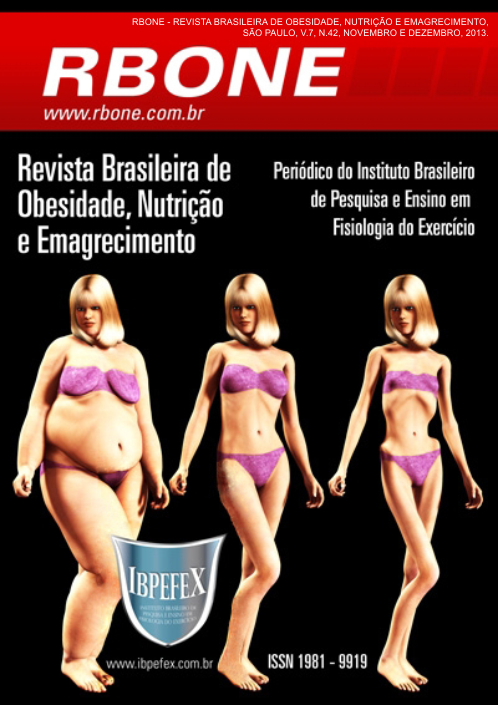Prevalence of overweight and obesity in school district officials ofa city in the West Paraná
Abstract
Objective: This study had as purpose to evaluate the nutritional status, the practice of physical exercises and the presence of chronical diseases in employees of a town in the west of Paraná. Materials and methods: Transversal study developed with adult employees of both genus in 2012, from August to November. It was collected data about the socio-demographic profile and nutritional evaluation, through the obtainment of weight and height, bodily circumference (BC) to evaluate the risk of diseases related to obesity development. On the other hand, the chronical diseases and the practice of physical exercises were considered the employee’s report. Results: From the female employees evaluated, 34% presented overweight, 17,6% obesity class I and 7,3% obesity class II while 50% of the men presented overweight, 16,6% obesity class I and 5,7% obesity class II. In the bodily circumference 50.2% of the employees presented risk to develop diseases related to obesity and 69.2% reported to be sedentary. In relation to the presence of disease 17.6% presented one or more of them. Discussion: Gigante and collaborators in a similar study in 2006, found 47% of the men and 39% of the women were overweight while 11% presented obesity, in both genus. Conclusion: The employees’ nutritional status is committed because most of them are overweight or obese.
References
-Bueno, J.M.; Martino, H.S.D.; Fernandes, M.F.S.; Costa, L.S.; Silva R.R. Avaliação nutricional e prevalência de doenças crônicas não transmissíveis em idosos pertencentes a um programa assistencial. Ciências & Saúde Coletiva. Vol. 13. p. 1237-1246. 2008.
-Bouchard, C. Atividade física e obesidade. São Paulo. Manole. p. 469. 2003.
-Coutinho,W. Etiologia da obesidade. Rev ABESO. 2007. Disponível em: <http://www.abeso.org.br/pdf/Etiologia%20e%20Fisiopatologia%20%20Walmir%20Coutinho.pdf>
-Cuppari, L. Guia de medicina ambulatorial e hospitalar: Nutrição clinica no adulto.2ª edição. São Paulo. Manole. 2005.
-Ewald, D.; Hofelmann, D.A.; Riekes, B.H.; Cherem, A.R.; Azevedo, L.C. Fatores de risco para doenças crônicas não-transmissíveis entre colaboradores internos de Unidade de Alimentação e Nutrição. In: Simpósio Internacional sobre Obesidade. Florianópolis. Universidade Federal de Santa Catarina. p. 13. 2003.
-Gigante, D.P.; Moura, E.C.; Sardinha, L.M.V. Prevalência de excesso de peso e obesidade e fatores associados, Brasil, 2006.Rev Saúde Pública. Vol. 43. Supl 2. p. 83-89. 2009.
-Instituto Brasileiro de Geografia e Estatística. Pesquisa de orçamentos familiares: POF 2002-2003. Disponível em: <http://www.ibge.gov.br>Acessado em 05/01/2013.
-Jenovesi, J.F.; Bracco, M.M.; Colugnat, F.A.B.; Taddei, J.A.A.C. Evolução no nível de atividade física de escolares observados pelo período de 1 ano. Revista Brasileira de Ciência e Movimento. Brasília. Vol. 12. Núm. 1. p. 19-24. 2004.
-Leão, L.S.C.S.; Araújo, L.M.B.; Moraes, L.T.L.P.; Assis, A.M. Prevalência de obesidade em escolares de Salvador.Bahia. Arq Bras Endocrinol Metab. Vol. 47. Núm. 2. p. 151-157. 2003.
-Lerário, D.D.G.; Gimeno, S.G.; Franco, L.J.; Lunes, M.; Ferreira, R.G. Excesso de peso e gordura abdominal para a síndrome metabólica em nipo-brasileiros. Rev. Saúde Pública. Vol. 36. p. 4-11. 2002.
-Mahan, L. K.; Escott-Stump, S. Krause: Alimentos, Nutrição & Dietoterapia. 9ªedição. São Paulo. Roca. p. 371-396. 1998.
-Mendes, B.; Alves, J.G.B.; Alves, A.V.; Siqueira, P.P.; Freire, E.F.C. Associação de fatores de risco para doenças cardiovasculares em adolescentes e seus pais. Revista Brasileira de Saúde Materna Infantil. Vol. 6. Supl. 1. 2006.
-Oliveira, C.L.; Fisberg, M. Obesidade na infância e adolescência: uma verdadeira epidemia. Arquivo Brasileiro de Endocrinologia e Metabologia. Vol. 47. Núm. 2. 2003.
-Organização Mundial Da Saúde. Obesity: preventing and managing the global epidemic. Genebra.1998.
-Secretaria de Políticas Públicas de Saúde, Ministério da Saúde. Programa nacional de promoção da atividade física “Agita Brasil”: atividade física e sua contribuição para a qualidade de vida. Rev Saúde Pública. Vol. 36. p. 254-256. 2002.
-Souza, L.J.; Gicovate, N.C.; Chalita, F.E.B.; Reis A.F.F.; Bastos, D.A.; Côrtes, V.A. Prevalência de obesidade e fatores de risco cardiovascular em Campos, Rio de Janeiro. Arq Bras Endocrinol Metab. Vol. 47. p. 669-676. 2003.
-World Health Organization. Physical status: the use and interpretation of anthropometry. Geneva. 1995.
-World Health Organization. Obesity: preventing and managing the Global Epidemic. Report on a WHO Expert Consultation onObesity, p. 3-5. Geneva. 1997.
Authors who publish in this journal agree to the following terms:
- Authors retain the copyright and grant the journal the right of first publication, with work simultaneously licensed under the Creative Commons Attribution License BY-NC which allows the sharing of the work with acknowledgment of the authorship of the work and initial publication in this journal.
- Authors are authorized to enter into additional contracts separately for non-exclusive distribution of the version of the work published in this journal (eg, publishing in institutional repository or book chapter), with acknowledgment of authorship and initial publication in this journal.
- Authors are allowed and encouraged to post and distribute their work online (eg, in institutional repositories or on their personal page) at any point before or during the editorial process, as this can bring about productive change as well as increase impact and impact. citation of published work (See The Effect of Free Access).






